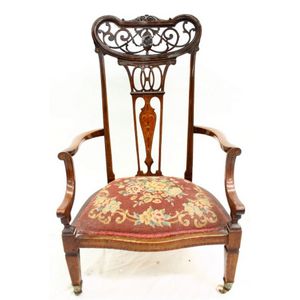Late Victorian Mahogany Armchair with Cream Sateen Upholstery
You must be a subscriber, and be logged in to view price and dealer details.
Subscribe Now to view actual auction price for this item
When you subscribe, you have the option of setting the currency in which to display prices to $Au, $US, $NZ or Stg.
- Victorian Period - The Victorian period of furniture and decorative arts design covers the reign of Queen Victoria from 1837 to 1901. There was not one dominant style of furniture in the Victorian period. Designers used and modified many historical styles such as Gothic, Tudor, Elizabethan, English Rococo, Neoclassical and others, although use of some styles, such as English Rococo and Gothic tended to dominate the furniture manufacture of the period.
The Victorian period was preceded by the Regency and William IV periods, and followed by the Edwardian period, named for Edward VII (1841 ? 1910) who was King of the United Kingdom and the British Dominions and Emperor of India for the brief period from 1901 until his death in 1910. - Mahogany - Mahogany is a dense, close grained red-coloured timber from the West Indies and Central America. It was first imported into Europe in the the early 18th century and its use continued through the 19th century. It was popular for furniture making because of its strength, the wide boards available, the distinctive grain on some boards, termed flame mahogany and the rich warm colour of the timber when it was polished.. The "flame" was produced where a limb grew out from the trunk of the tree, and this timber was usually sliced into veneers for feature panels on doors, backs and cornices.
Some terms used to describe mahogany relate to the country from which it originally came, such as "Cuban" mahogany, "Honduras" mahogany etc. However unless the wood has been tested the names assigned are more a selling feature, rather than a true indication of the timber's origin. - Turned Legs - are legs which have been turned on a lathe. In use from the 16th century, turned legs on tables, chairs and cabinets became more frequent until, by the 1830s, the Georgian square or tapered leg was rarely found except in country pieces.
- Turning - Any part of a piece of furniture that has been turned and shaped with chisels on a lathe. Turned sections include legs, columns, feet, finials, pedestals, stretchers, spindles etc. There have been many varieties and fashions over the centuries: baluster, melon, barley-sugar, bobbin, cotton-reel, rope-twist, and so on. Split turning implies a turned section that has been cut in half lengthwise and applied to a cabinet front as a false decorative support.
This item has been included into following indexes:
-
chairs, singles / pairs / threes, style or period
- armchairs 1,769
- Victorian, other styles 1,220
- chairs, singles / pairs / threes, timber - mahogany 1,129
Visually similar items

A Edwardian mahogany nursing chair, c.1910, with inlay and upholstered with tapestry, some minor fretwork damage, aged upholstered tapestry complete, white porcelain castors in tact, height 96 cm

A quality walnut late Victorian bedroom/nursing chair with classical carving to back centre slat

A George III mahogany Hepplewhite elbow chair with arched back, and vase shaped splat on square tapering legs, with stretchers, circa 1785. Provenance: Robert Milne Brand, Windsor Antiques, The Estate of Stanley Crawford Stevens.

A fine Edwardian inlaid rosewood open arm chair, circa 1900, of elegant sinuous lines with Art Nouveau influence, having a shield style back with scrolled cresting rail above an inlaid vasiform splat flanked by slender curvaceous splats, the arms with exag
